Report on Design, Production, and Customer Needs for Nike Products
VerifiedAdded on 2020/09/03
|38
|6295
|187
Report
AI Summary
This report delves into the design and production of clothing and shoes, focusing on Nike as a case study. It begins with an introduction to the apparel industry and Nike's market position, followed by an analysis of customer satisfaction, including stakeholder identification and customer needs assessment using the Kano model. The report then outlines design requirements, risk analysis using FEMA, and supplier selection criteria. Statistical process control (SPC) is explored, with the identification of processes, construction, and interpretation of SPC charts. Finally, the report addresses problem-solving techniques used in the production process. The report covers various aspects of the company, from customer needs and wants to the selection of suppliers and the control of the statistical process. Tables and illustrations are used to support the analysis.

REPORT
Paraphrase This Document
Need a fresh take? Get an instant paraphrase of this document with our AI Paraphraser
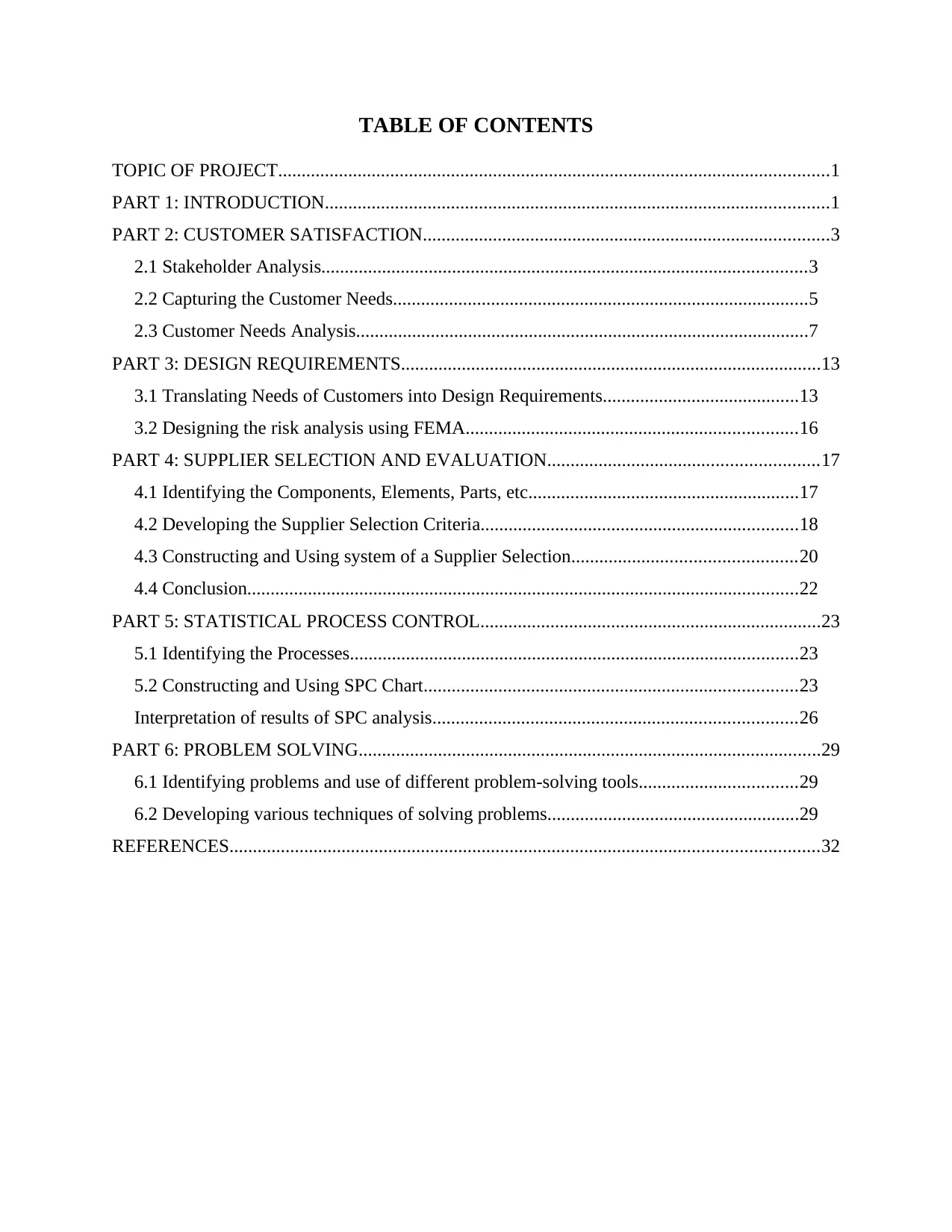
TABLE OF CONTENTS
TOPIC OF PROJECT......................................................................................................................1
PART 1: INTRODUCTION............................................................................................................1
PART 2: CUSTOMER SATISFACTION.......................................................................................3
2.1 Stakeholder Analysis........................................................................................................3
2.2 Capturing the Customer Needs.........................................................................................5
2.3 Customer Needs Analysis.................................................................................................7
PART 3: DESIGN REQUIREMENTS..........................................................................................13
3.1 Translating Needs of Customers into Design Requirements..........................................13
3.2 Designing the risk analysis using FEMA.......................................................................16
PART 4: SUPPLIER SELECTION AND EVALUATION..........................................................17
4.1 Identifying the Components, Elements, Parts, etc..........................................................17
4.2 Developing the Supplier Selection Criteria....................................................................18
4.3 Constructing and Using system of a Supplier Selection................................................20
4.4 Conclusion......................................................................................................................22
PART 5: STATISTICAL PROCESS CONTROL.........................................................................23
5.1 Identifying the Processes................................................................................................23
5.2 Constructing and Using SPC Chart................................................................................23
Interpretation of results of SPC analysis..............................................................................26
PART 6: PROBLEM SOLVING...................................................................................................29
6.1 Identifying problems and use of different problem-solving tools..................................29
6.2 Developing various techniques of solving problems......................................................29
REFERENCES..............................................................................................................................32
TOPIC OF PROJECT......................................................................................................................1
PART 1: INTRODUCTION............................................................................................................1
PART 2: CUSTOMER SATISFACTION.......................................................................................3
2.1 Stakeholder Analysis........................................................................................................3
2.2 Capturing the Customer Needs.........................................................................................5
2.3 Customer Needs Analysis.................................................................................................7
PART 3: DESIGN REQUIREMENTS..........................................................................................13
3.1 Translating Needs of Customers into Design Requirements..........................................13
3.2 Designing the risk analysis using FEMA.......................................................................16
PART 4: SUPPLIER SELECTION AND EVALUATION..........................................................17
4.1 Identifying the Components, Elements, Parts, etc..........................................................17
4.2 Developing the Supplier Selection Criteria....................................................................18
4.3 Constructing and Using system of a Supplier Selection................................................20
4.4 Conclusion......................................................................................................................22
PART 5: STATISTICAL PROCESS CONTROL.........................................................................23
5.1 Identifying the Processes................................................................................................23
5.2 Constructing and Using SPC Chart................................................................................23
Interpretation of results of SPC analysis..............................................................................26
PART 6: PROBLEM SOLVING...................................................................................................29
6.1 Identifying problems and use of different problem-solving tools..................................29
6.2 Developing various techniques of solving problems......................................................29
REFERENCES..............................................................................................................................32
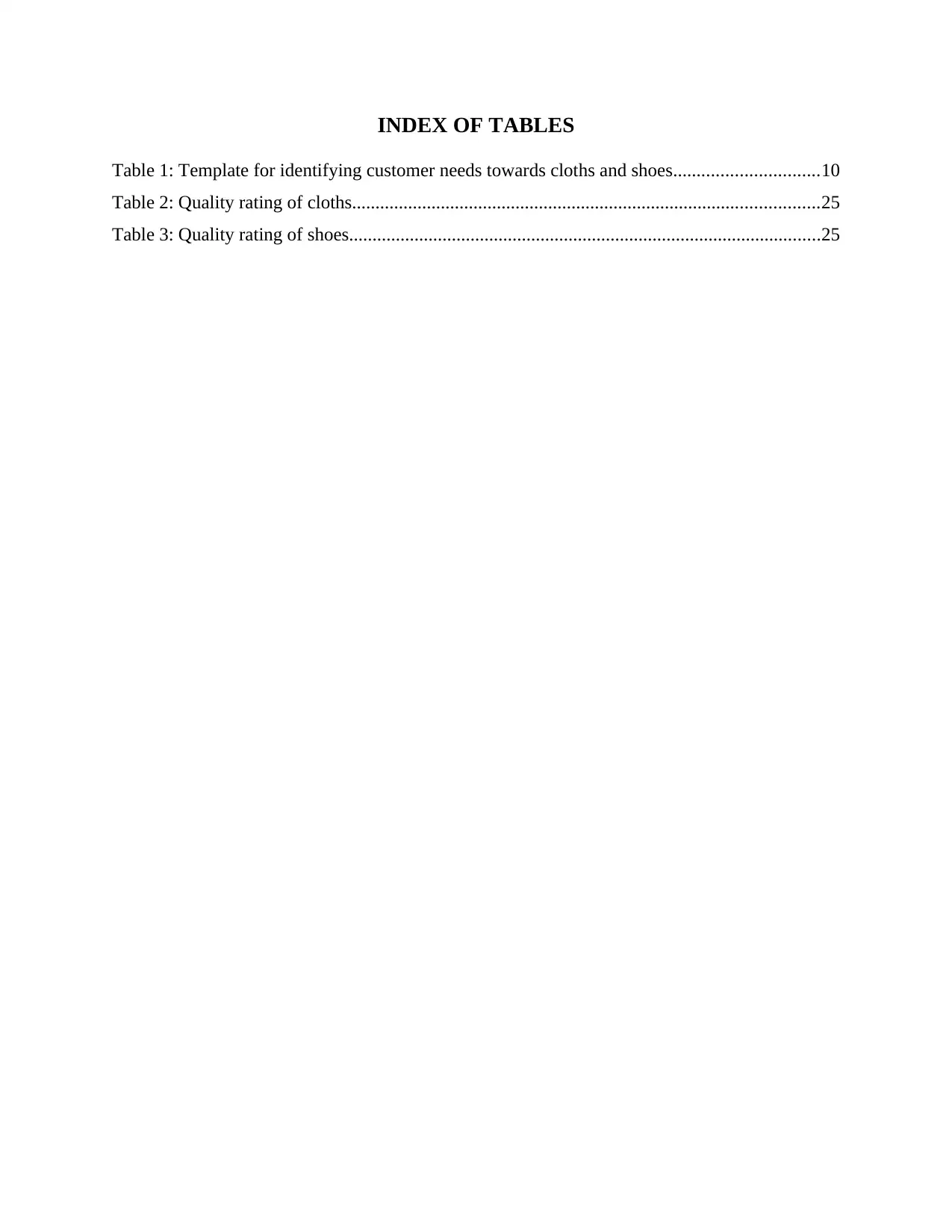
INDEX OF TABLES
Table 1: Template for identifying customer needs towards cloths and shoes...............................10
Table 2: Quality rating of cloths....................................................................................................25
Table 3: Quality rating of shoes.....................................................................................................25
Table 1: Template for identifying customer needs towards cloths and shoes...............................10
Table 2: Quality rating of cloths....................................................................................................25
Table 3: Quality rating of shoes.....................................................................................................25
⊘ This is a preview!⊘
Do you want full access?
Subscribe today to unlock all pages.

Trusted by 1+ million students worldwide
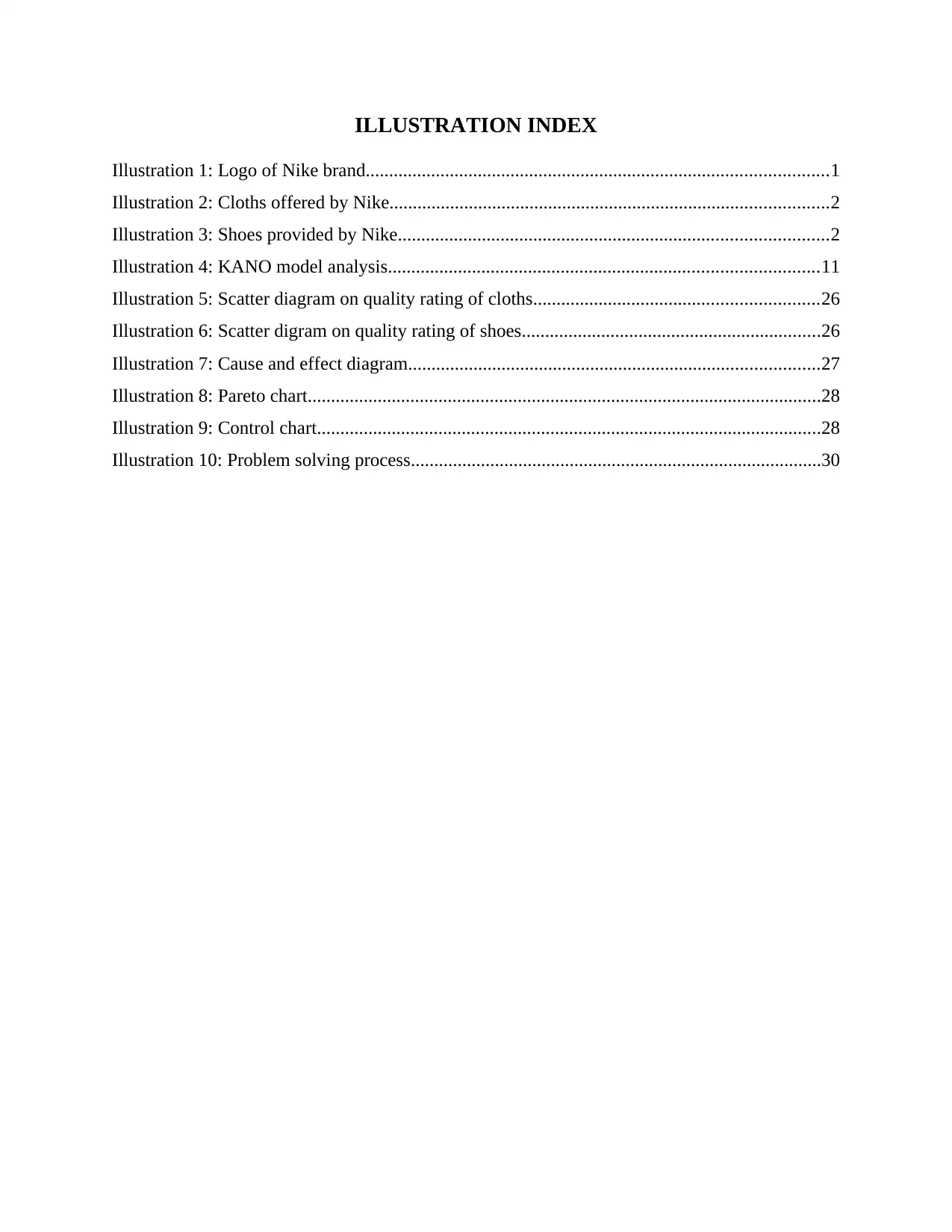
ILLUSTRATION INDEX
Illustration 1: Logo of Nike brand...................................................................................................1
Illustration 2: Cloths offered by Nike..............................................................................................2
Illustration 3: Shoes provided by Nike............................................................................................2
Illustration 4: KANO model analysis............................................................................................11
Illustration 5: Scatter diagram on quality rating of cloths.............................................................26
Illustration 6: Scatter digram on quality rating of shoes................................................................26
Illustration 7: Cause and effect diagram........................................................................................27
Illustration 8: Pareto chart..............................................................................................................28
Illustration 9: Control chart............................................................................................................28
Illustration 10: Problem solving process........................................................................................30
Illustration 1: Logo of Nike brand...................................................................................................1
Illustration 2: Cloths offered by Nike..............................................................................................2
Illustration 3: Shoes provided by Nike............................................................................................2
Illustration 4: KANO model analysis............................................................................................11
Illustration 5: Scatter diagram on quality rating of cloths.............................................................26
Illustration 6: Scatter digram on quality rating of shoes................................................................26
Illustration 7: Cause and effect diagram........................................................................................27
Illustration 8: Pareto chart..............................................................................................................28
Illustration 9: Control chart............................................................................................................28
Illustration 10: Problem solving process........................................................................................30
Paraphrase This Document
Need a fresh take? Get an instant paraphrase of this document with our AI Paraphraser
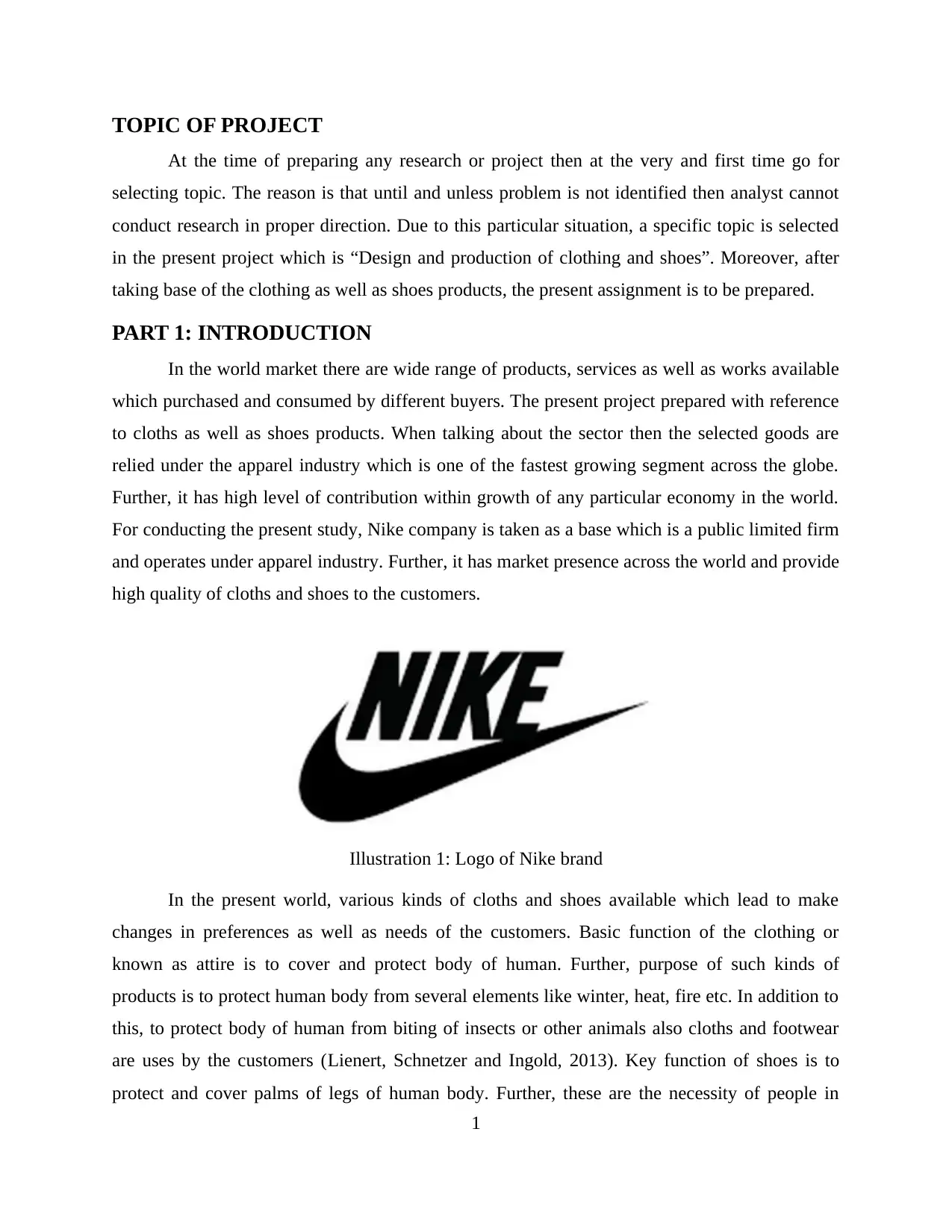
TOPIC OF PROJECT
At the time of preparing any research or project then at the very and first time go for
selecting topic. The reason is that until and unless problem is not identified then analyst cannot
conduct research in proper direction. Due to this particular situation, a specific topic is selected
in the present project which is “Design and production of clothing and shoes”. Moreover, after
taking base of the clothing as well as shoes products, the present assignment is to be prepared.
PART 1: INTRODUCTION
In the world market there are wide range of products, services as well as works available
which purchased and consumed by different buyers. The present project prepared with reference
to cloths as well as shoes products. When talking about the sector then the selected goods are
relied under the apparel industry which is one of the fastest growing segment across the globe.
Further, it has high level of contribution within growth of any particular economy in the world.
For conducting the present study, Nike company is taken as a base which is a public limited firm
and operates under apparel industry. Further, it has market presence across the world and provide
high quality of cloths and shoes to the customers.
Illustration 1: Logo of Nike brand
In the present world, various kinds of cloths and shoes available which lead to make
changes in preferences as well as needs of the customers. Basic function of the clothing or
known as attire is to cover and protect body of human. Further, purpose of such kinds of
products is to protect human body from several elements like winter, heat, fire etc. In addition to
this, to protect body of human from biting of insects or other animals also cloths and footwear
are uses by the customers (Lienert, Schnetzer and Ingold, 2013). Key function of shoes is to
protect and cover palms of legs of human body. Further, these are the necessity of people in
1
At the time of preparing any research or project then at the very and first time go for
selecting topic. The reason is that until and unless problem is not identified then analyst cannot
conduct research in proper direction. Due to this particular situation, a specific topic is selected
in the present project which is “Design and production of clothing and shoes”. Moreover, after
taking base of the clothing as well as shoes products, the present assignment is to be prepared.
PART 1: INTRODUCTION
In the world market there are wide range of products, services as well as works available
which purchased and consumed by different buyers. The present project prepared with reference
to cloths as well as shoes products. When talking about the sector then the selected goods are
relied under the apparel industry which is one of the fastest growing segment across the globe.
Further, it has high level of contribution within growth of any particular economy in the world.
For conducting the present study, Nike company is taken as a base which is a public limited firm
and operates under apparel industry. Further, it has market presence across the world and provide
high quality of cloths and shoes to the customers.
Illustration 1: Logo of Nike brand
In the present world, various kinds of cloths and shoes available which lead to make
changes in preferences as well as needs of the customers. Basic function of the clothing or
known as attire is to cover and protect body of human. Further, purpose of such kinds of
products is to protect human body from several elements like winter, heat, fire etc. In addition to
this, to protect body of human from biting of insects or other animals also cloths and footwear
are uses by the customers (Lienert, Schnetzer and Ingold, 2013). Key function of shoes is to
protect and cover palms of legs of human body. Further, these are the necessity of people in
1
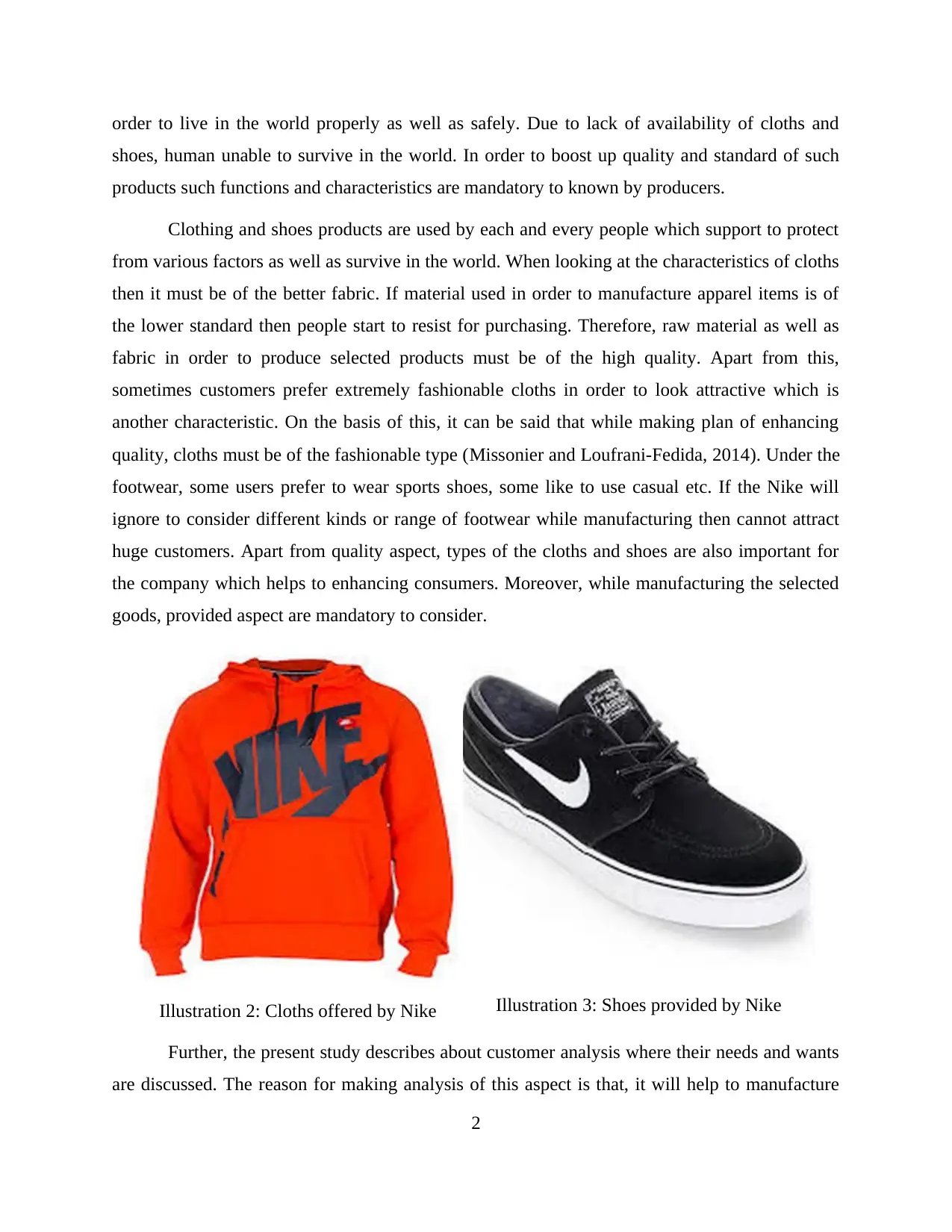
order to live in the world properly as well as safely. Due to lack of availability of cloths and
shoes, human unable to survive in the world. In order to boost up quality and standard of such
products such functions and characteristics are mandatory to known by producers.
Clothing and shoes products are used by each and every people which support to protect
from various factors as well as survive in the world. When looking at the characteristics of cloths
then it must be of the better fabric. If material used in order to manufacture apparel items is of
the lower standard then people start to resist for purchasing. Therefore, raw material as well as
fabric in order to produce selected products must be of the high quality. Apart from this,
sometimes customers prefer extremely fashionable cloths in order to look attractive which is
another characteristic. On the basis of this, it can be said that while making plan of enhancing
quality, cloths must be of the fashionable type (Missonier and Loufrani-Fedida, 2014). Under the
footwear, some users prefer to wear sports shoes, some like to use casual etc. If the Nike will
ignore to consider different kinds or range of footwear while manufacturing then cannot attract
huge customers. Apart from quality aspect, types of the cloths and shoes are also important for
the company which helps to enhancing consumers. Moreover, while manufacturing the selected
goods, provided aspect are mandatory to consider.
Illustration 2: Cloths offered by Nike Illustration 3: Shoes provided by Nike
Further, the present study describes about customer analysis where their needs and wants
are discussed. The reason for making analysis of this aspect is that, it will help to manufacture
2
shoes, human unable to survive in the world. In order to boost up quality and standard of such
products such functions and characteristics are mandatory to known by producers.
Clothing and shoes products are used by each and every people which support to protect
from various factors as well as survive in the world. When looking at the characteristics of cloths
then it must be of the better fabric. If material used in order to manufacture apparel items is of
the lower standard then people start to resist for purchasing. Therefore, raw material as well as
fabric in order to produce selected products must be of the high quality. Apart from this,
sometimes customers prefer extremely fashionable cloths in order to look attractive which is
another characteristic. On the basis of this, it can be said that while making plan of enhancing
quality, cloths must be of the fashionable type (Missonier and Loufrani-Fedida, 2014). Under the
footwear, some users prefer to wear sports shoes, some like to use casual etc. If the Nike will
ignore to consider different kinds or range of footwear while manufacturing then cannot attract
huge customers. Apart from quality aspect, types of the cloths and shoes are also important for
the company which helps to enhancing consumers. Moreover, while manufacturing the selected
goods, provided aspect are mandatory to consider.
Illustration 2: Cloths offered by Nike Illustration 3: Shoes provided by Nike
Further, the present study describes about customer analysis where their needs and wants
are discussed. The reason for making analysis of this aspect is that, it will help to manufacture
2
⊘ This is a preview!⊘
Do you want full access?
Subscribe today to unlock all pages.

Trusted by 1+ million students worldwide
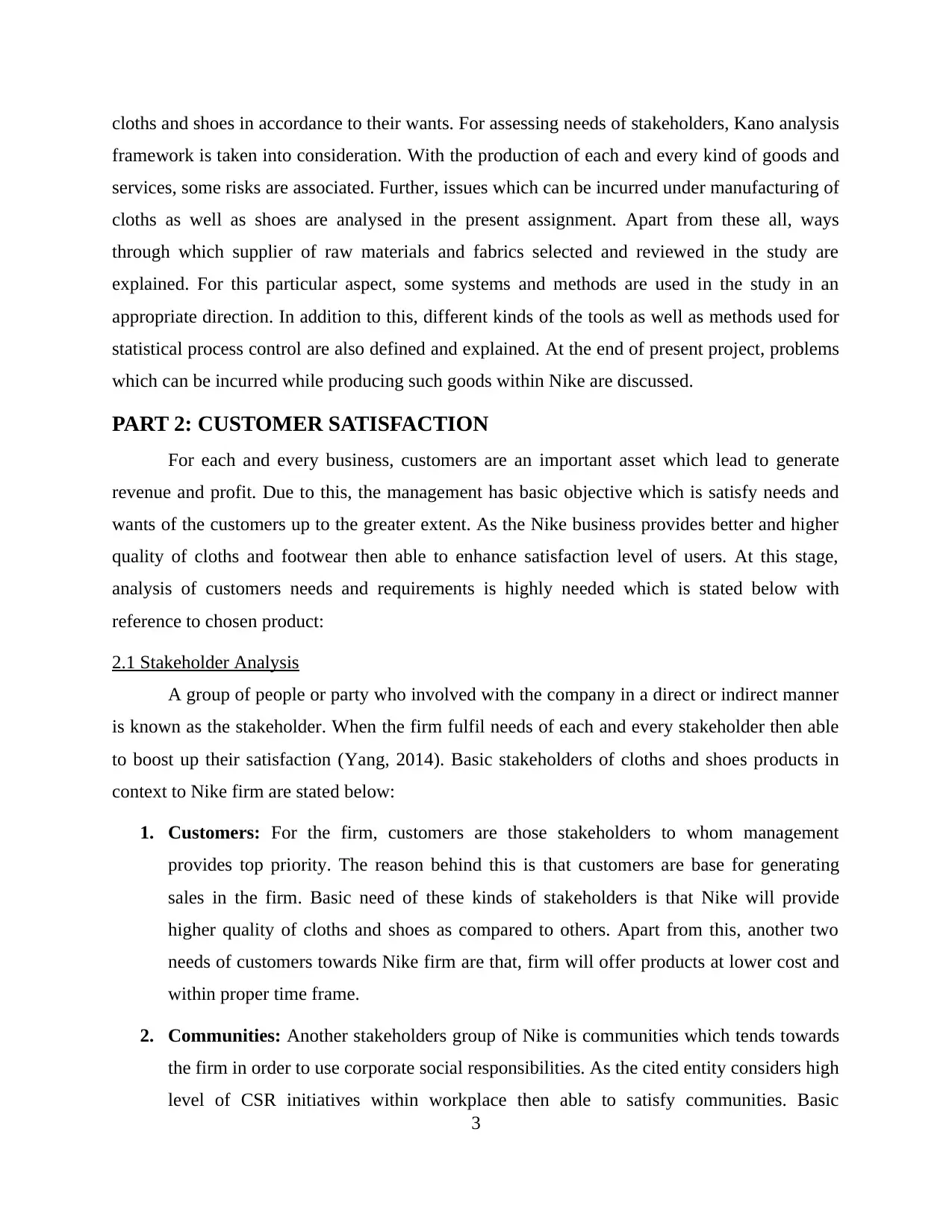
cloths and shoes in accordance to their wants. For assessing needs of stakeholders, Kano analysis
framework is taken into consideration. With the production of each and every kind of goods and
services, some risks are associated. Further, issues which can be incurred under manufacturing of
cloths as well as shoes are analysed in the present assignment. Apart from these all, ways
through which supplier of raw materials and fabrics selected and reviewed in the study are
explained. For this particular aspect, some systems and methods are used in the study in an
appropriate direction. In addition to this, different kinds of the tools as well as methods used for
statistical process control are also defined and explained. At the end of present project, problems
which can be incurred while producing such goods within Nike are discussed.
PART 2: CUSTOMER SATISFACTION
For each and every business, customers are an important asset which lead to generate
revenue and profit. Due to this, the management has basic objective which is satisfy needs and
wants of the customers up to the greater extent. As the Nike business provides better and higher
quality of cloths and footwear then able to enhance satisfaction level of users. At this stage,
analysis of customers needs and requirements is highly needed which is stated below with
reference to chosen product:
2.1 Stakeholder Analysis
A group of people or party who involved with the company in a direct or indirect manner
is known as the stakeholder. When the firm fulfil needs of each and every stakeholder then able
to boost up their satisfaction (Yang, 2014). Basic stakeholders of cloths and shoes products in
context to Nike firm are stated below:
1. Customers: For the firm, customers are those stakeholders to whom management
provides top priority. The reason behind this is that customers are base for generating
sales in the firm. Basic need of these kinds of stakeholders is that Nike will provide
higher quality of cloths and shoes as compared to others. Apart from this, another two
needs of customers towards Nike firm are that, firm will offer products at lower cost and
within proper time frame.
2. Communities: Another stakeholders group of Nike is communities which tends towards
the firm in order to use corporate social responsibilities. As the cited entity considers high
level of CSR initiatives within workplace then able to satisfy communities. Basic
3
framework is taken into consideration. With the production of each and every kind of goods and
services, some risks are associated. Further, issues which can be incurred under manufacturing of
cloths as well as shoes are analysed in the present assignment. Apart from these all, ways
through which supplier of raw materials and fabrics selected and reviewed in the study are
explained. For this particular aspect, some systems and methods are used in the study in an
appropriate direction. In addition to this, different kinds of the tools as well as methods used for
statistical process control are also defined and explained. At the end of present project, problems
which can be incurred while producing such goods within Nike are discussed.
PART 2: CUSTOMER SATISFACTION
For each and every business, customers are an important asset which lead to generate
revenue and profit. Due to this, the management has basic objective which is satisfy needs and
wants of the customers up to the greater extent. As the Nike business provides better and higher
quality of cloths and footwear then able to enhance satisfaction level of users. At this stage,
analysis of customers needs and requirements is highly needed which is stated below with
reference to chosen product:
2.1 Stakeholder Analysis
A group of people or party who involved with the company in a direct or indirect manner
is known as the stakeholder. When the firm fulfil needs of each and every stakeholder then able
to boost up their satisfaction (Yang, 2014). Basic stakeholders of cloths and shoes products in
context to Nike firm are stated below:
1. Customers: For the firm, customers are those stakeholders to whom management
provides top priority. The reason behind this is that customers are base for generating
sales in the firm. Basic need of these kinds of stakeholders is that Nike will provide
higher quality of cloths and shoes as compared to others. Apart from this, another two
needs of customers towards Nike firm are that, firm will offer products at lower cost and
within proper time frame.
2. Communities: Another stakeholders group of Nike is communities which tends towards
the firm in order to use corporate social responsibilities. As the cited entity considers high
level of CSR initiatives within workplace then able to satisfy communities. Basic
3
Paraphrase This Document
Need a fresh take? Get an instant paraphrase of this document with our AI Paraphraser
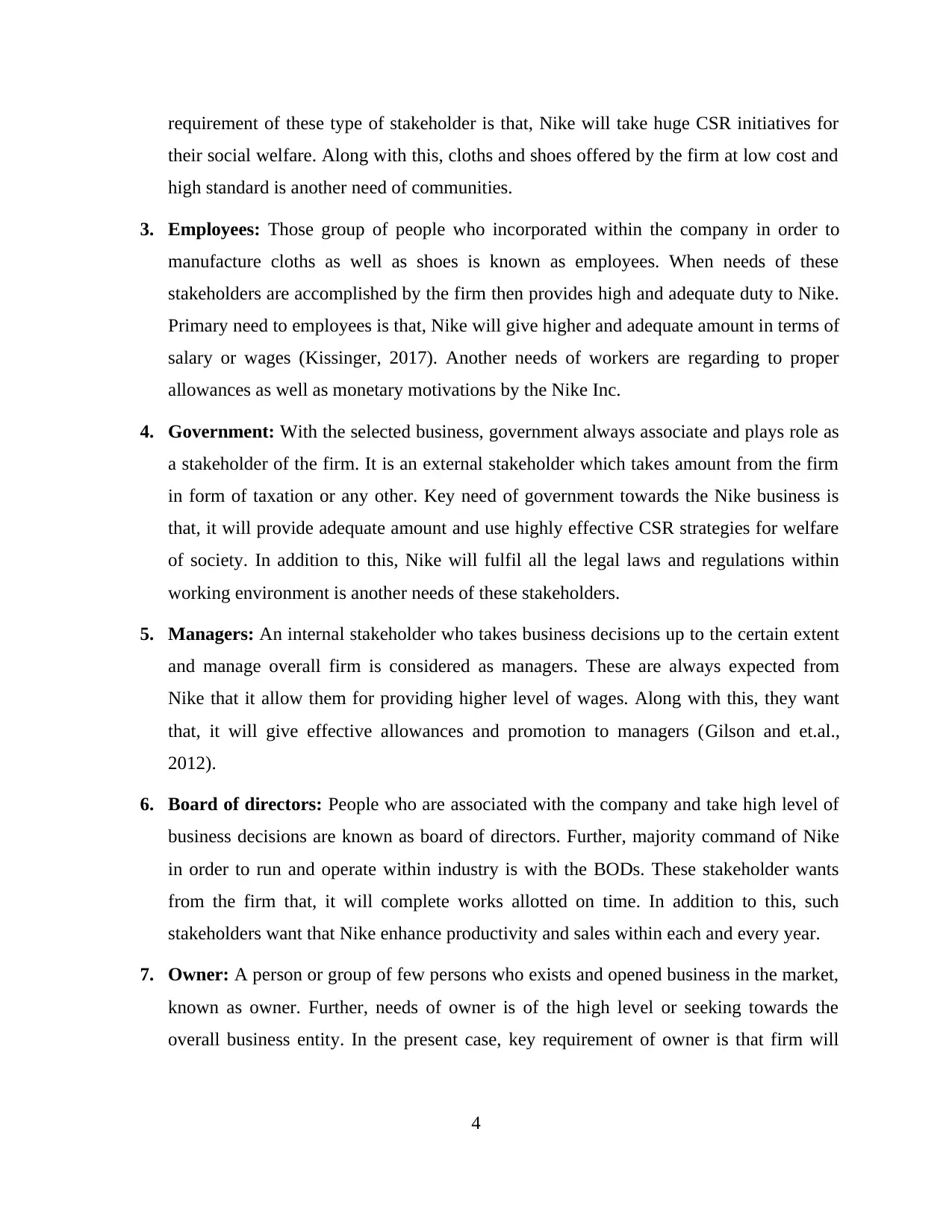
requirement of these type of stakeholder is that, Nike will take huge CSR initiatives for
their social welfare. Along with this, cloths and shoes offered by the firm at low cost and
high standard is another need of communities.
3. Employees: Those group of people who incorporated within the company in order to
manufacture cloths as well as shoes is known as employees. When needs of these
stakeholders are accomplished by the firm then provides high and adequate duty to Nike.
Primary need to employees is that, Nike will give higher and adequate amount in terms of
salary or wages (Kissinger, 2017). Another needs of workers are regarding to proper
allowances as well as monetary motivations by the Nike Inc.
4. Government: With the selected business, government always associate and plays role as
a stakeholder of the firm. It is an external stakeholder which takes amount from the firm
in form of taxation or any other. Key need of government towards the Nike business is
that, it will provide adequate amount and use highly effective CSR strategies for welfare
of society. In addition to this, Nike will fulfil all the legal laws and regulations within
working environment is another needs of these stakeholders.
5. Managers: An internal stakeholder who takes business decisions up to the certain extent
and manage overall firm is considered as managers. These are always expected from
Nike that it allow them for providing higher level of wages. Along with this, they want
that, it will give effective allowances and promotion to managers (Gilson and et.al.,
2012).
6. Board of directors: People who are associated with the company and take high level of
business decisions are known as board of directors. Further, majority command of Nike
in order to run and operate within industry is with the BODs. These stakeholder wants
from the firm that, it will complete works allotted on time. In addition to this, such
stakeholders want that Nike enhance productivity and sales within each and every year.
7. Owner: A person or group of few persons who exists and opened business in the market,
known as owner. Further, needs of owner is of the high level or seeking towards the
overall business entity. In the present case, key requirement of owner is that firm will
4
their social welfare. Along with this, cloths and shoes offered by the firm at low cost and
high standard is another need of communities.
3. Employees: Those group of people who incorporated within the company in order to
manufacture cloths as well as shoes is known as employees. When needs of these
stakeholders are accomplished by the firm then provides high and adequate duty to Nike.
Primary need to employees is that, Nike will give higher and adequate amount in terms of
salary or wages (Kissinger, 2017). Another needs of workers are regarding to proper
allowances as well as monetary motivations by the Nike Inc.
4. Government: With the selected business, government always associate and plays role as
a stakeholder of the firm. It is an external stakeholder which takes amount from the firm
in form of taxation or any other. Key need of government towards the Nike business is
that, it will provide adequate amount and use highly effective CSR strategies for welfare
of society. In addition to this, Nike will fulfil all the legal laws and regulations within
working environment is another needs of these stakeholders.
5. Managers: An internal stakeholder who takes business decisions up to the certain extent
and manage overall firm is considered as managers. These are always expected from
Nike that it allow them for providing higher level of wages. Along with this, they want
that, it will give effective allowances and promotion to managers (Gilson and et.al.,
2012).
6. Board of directors: People who are associated with the company and take high level of
business decisions are known as board of directors. Further, majority command of Nike
in order to run and operate within industry is with the BODs. These stakeholder wants
from the firm that, it will complete works allotted on time. In addition to this, such
stakeholders want that Nike enhance productivity and sales within each and every year.
7. Owner: A person or group of few persons who exists and opened business in the market,
known as owner. Further, needs of owner is of the high level or seeking towards the
overall business entity. In the present case, key requirement of owner is that firm will
4
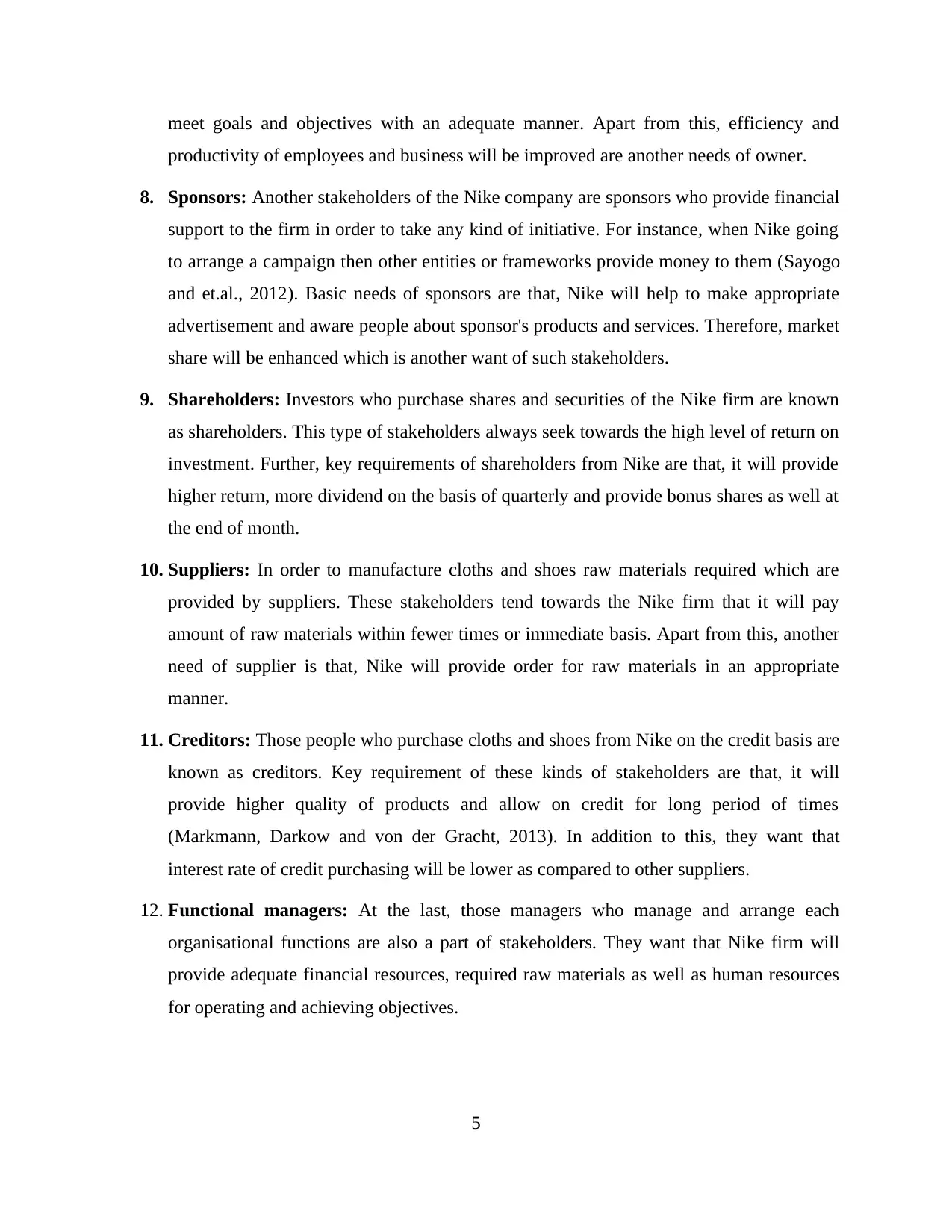
meet goals and objectives with an adequate manner. Apart from this, efficiency and
productivity of employees and business will be improved are another needs of owner.
8. Sponsors: Another stakeholders of the Nike company are sponsors who provide financial
support to the firm in order to take any kind of initiative. For instance, when Nike going
to arrange a campaign then other entities or frameworks provide money to them (Sayogo
and et.al., 2012). Basic needs of sponsors are that, Nike will help to make appropriate
advertisement and aware people about sponsor's products and services. Therefore, market
share will be enhanced which is another want of such stakeholders.
9. Shareholders: Investors who purchase shares and securities of the Nike firm are known
as shareholders. This type of stakeholders always seek towards the high level of return on
investment. Further, key requirements of shareholders from Nike are that, it will provide
higher return, more dividend on the basis of quarterly and provide bonus shares as well at
the end of month.
10. Suppliers: In order to manufacture cloths and shoes raw materials required which are
provided by suppliers. These stakeholders tend towards the Nike firm that it will pay
amount of raw materials within fewer times or immediate basis. Apart from this, another
need of supplier is that, Nike will provide order for raw materials in an appropriate
manner.
11. Creditors: Those people who purchase cloths and shoes from Nike on the credit basis are
known as creditors. Key requirement of these kinds of stakeholders are that, it will
provide higher quality of products and allow on credit for long period of times
(Markmann, Darkow and von der Gracht, 2013). In addition to this, they want that
interest rate of credit purchasing will be lower as compared to other suppliers.
12. Functional managers: At the last, those managers who manage and arrange each
organisational functions are also a part of stakeholders. They want that Nike firm will
provide adequate financial resources, required raw materials as well as human resources
for operating and achieving objectives.
5
productivity of employees and business will be improved are another needs of owner.
8. Sponsors: Another stakeholders of the Nike company are sponsors who provide financial
support to the firm in order to take any kind of initiative. For instance, when Nike going
to arrange a campaign then other entities or frameworks provide money to them (Sayogo
and et.al., 2012). Basic needs of sponsors are that, Nike will help to make appropriate
advertisement and aware people about sponsor's products and services. Therefore, market
share will be enhanced which is another want of such stakeholders.
9. Shareholders: Investors who purchase shares and securities of the Nike firm are known
as shareholders. This type of stakeholders always seek towards the high level of return on
investment. Further, key requirements of shareholders from Nike are that, it will provide
higher return, more dividend on the basis of quarterly and provide bonus shares as well at
the end of month.
10. Suppliers: In order to manufacture cloths and shoes raw materials required which are
provided by suppliers. These stakeholders tend towards the Nike firm that it will pay
amount of raw materials within fewer times or immediate basis. Apart from this, another
need of supplier is that, Nike will provide order for raw materials in an appropriate
manner.
11. Creditors: Those people who purchase cloths and shoes from Nike on the credit basis are
known as creditors. Key requirement of these kinds of stakeholders are that, it will
provide higher quality of products and allow on credit for long period of times
(Markmann, Darkow and von der Gracht, 2013). In addition to this, they want that
interest rate of credit purchasing will be lower as compared to other suppliers.
12. Functional managers: At the last, those managers who manage and arrange each
organisational functions are also a part of stakeholders. They want that Nike firm will
provide adequate financial resources, required raw materials as well as human resources
for operating and achieving objectives.
5
⊘ This is a preview!⊘
Do you want full access?
Subscribe today to unlock all pages.

Trusted by 1+ million students worldwide
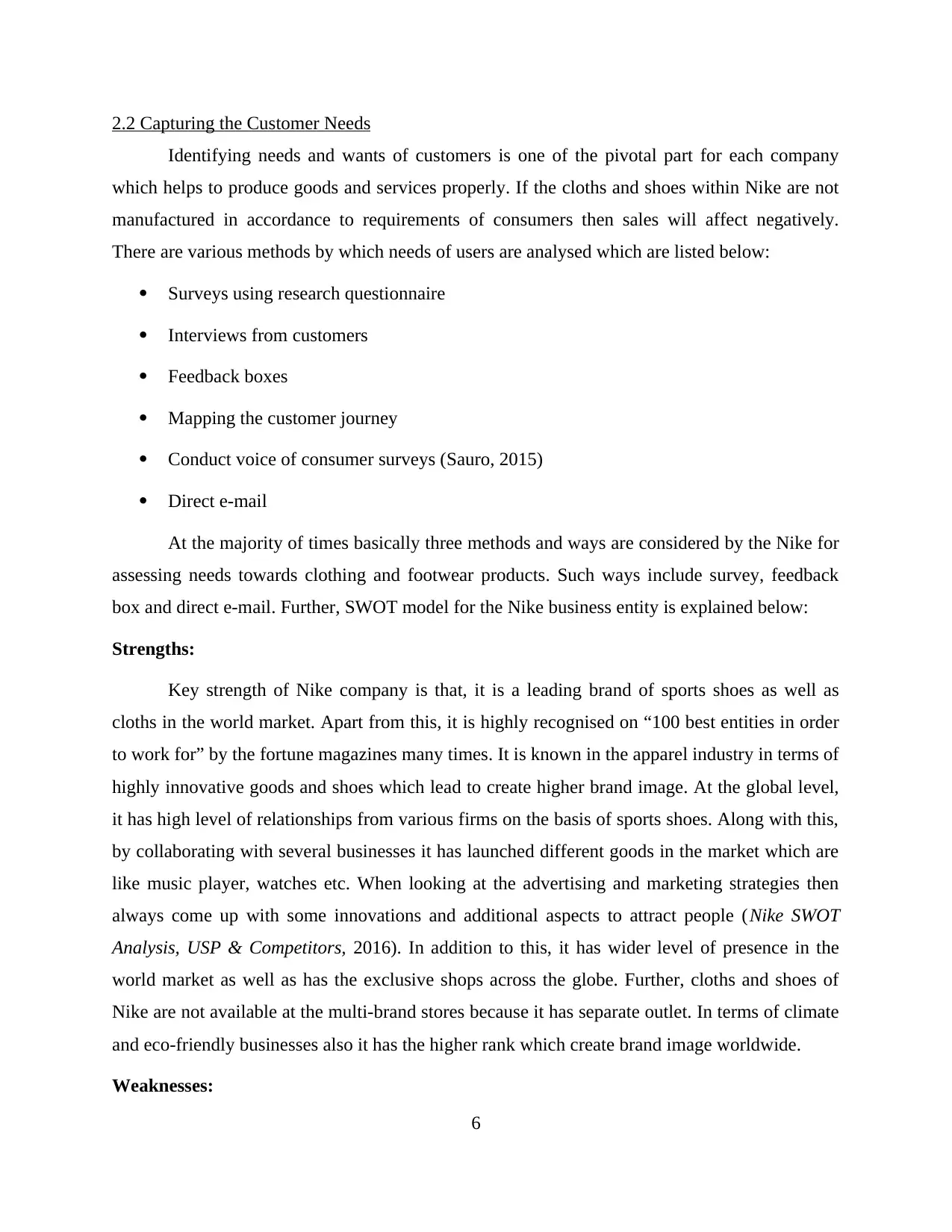
2.2 Capturing the Customer Needs
Identifying needs and wants of customers is one of the pivotal part for each company
which helps to produce goods and services properly. If the cloths and shoes within Nike are not
manufactured in accordance to requirements of consumers then sales will affect negatively.
There are various methods by which needs of users are analysed which are listed below:
Surveys using research questionnaire
Interviews from customers
Feedback boxes
Mapping the customer journey
Conduct voice of consumer surveys (Sauro, 2015)
Direct e-mail
At the majority of times basically three methods and ways are considered by the Nike for
assessing needs towards clothing and footwear products. Such ways include survey, feedback
box and direct e-mail. Further, SWOT model for the Nike business entity is explained below:
Strengths:
Key strength of Nike company is that, it is a leading brand of sports shoes as well as
cloths in the world market. Apart from this, it is highly recognised on “100 best entities in order
to work for” by the fortune magazines many times. It is known in the apparel industry in terms of
highly innovative goods and shoes which lead to create higher brand image. At the global level,
it has high level of relationships from various firms on the basis of sports shoes. Along with this,
by collaborating with several businesses it has launched different goods in the market which are
like music player, watches etc. When looking at the advertising and marketing strategies then
always come up with some innovations and additional aspects to attract people (Nike SWOT
Analysis, USP & Competitors, 2016). In addition to this, it has wider level of presence in the
world market as well as has the exclusive shops across the globe. Further, cloths and shoes of
Nike are not available at the multi-brand stores because it has separate outlet. In terms of climate
and eco-friendly businesses also it has the higher rank which create brand image worldwide.
Weaknesses:
6
Identifying needs and wants of customers is one of the pivotal part for each company
which helps to produce goods and services properly. If the cloths and shoes within Nike are not
manufactured in accordance to requirements of consumers then sales will affect negatively.
There are various methods by which needs of users are analysed which are listed below:
Surveys using research questionnaire
Interviews from customers
Feedback boxes
Mapping the customer journey
Conduct voice of consumer surveys (Sauro, 2015)
Direct e-mail
At the majority of times basically three methods and ways are considered by the Nike for
assessing needs towards clothing and footwear products. Such ways include survey, feedback
box and direct e-mail. Further, SWOT model for the Nike business entity is explained below:
Strengths:
Key strength of Nike company is that, it is a leading brand of sports shoes as well as
cloths in the world market. Apart from this, it is highly recognised on “100 best entities in order
to work for” by the fortune magazines many times. It is known in the apparel industry in terms of
highly innovative goods and shoes which lead to create higher brand image. At the global level,
it has high level of relationships from various firms on the basis of sports shoes. Along with this,
by collaborating with several businesses it has launched different goods in the market which are
like music player, watches etc. When looking at the advertising and marketing strategies then
always come up with some innovations and additional aspects to attract people (Nike SWOT
Analysis, USP & Competitors, 2016). In addition to this, it has wider level of presence in the
world market as well as has the exclusive shops across the globe. Further, cloths and shoes of
Nike are not available at the multi-brand stores because it has separate outlet. In terms of climate
and eco-friendly businesses also it has the higher rank which create brand image worldwide.
Weaknesses:
6
Paraphrase This Document
Need a fresh take? Get an instant paraphrase of this document with our AI Paraphraser
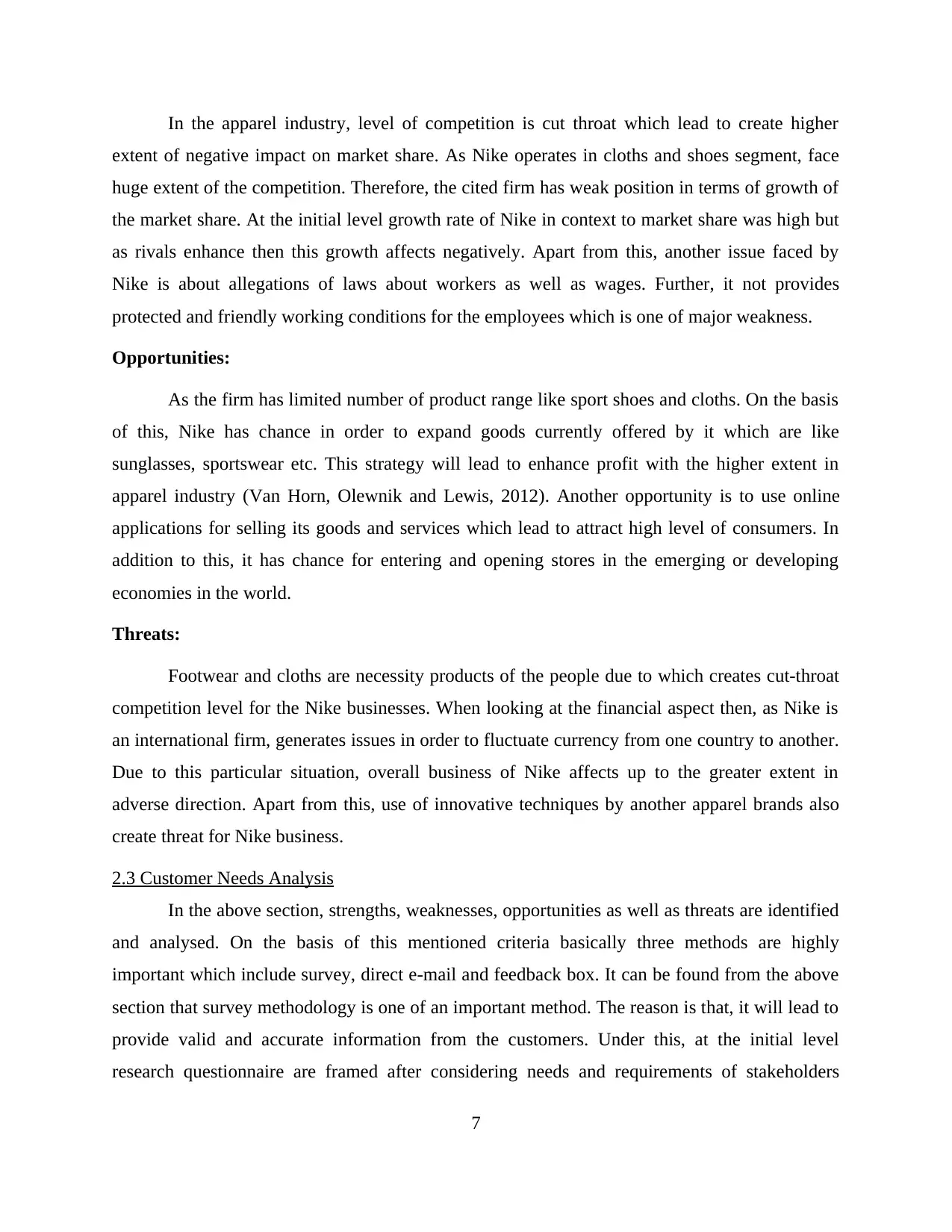
In the apparel industry, level of competition is cut throat which lead to create higher
extent of negative impact on market share. As Nike operates in cloths and shoes segment, face
huge extent of the competition. Therefore, the cited firm has weak position in terms of growth of
the market share. At the initial level growth rate of Nike in context to market share was high but
as rivals enhance then this growth affects negatively. Apart from this, another issue faced by
Nike is about allegations of laws about workers as well as wages. Further, it not provides
protected and friendly working conditions for the employees which is one of major weakness.
Opportunities:
As the firm has limited number of product range like sport shoes and cloths. On the basis
of this, Nike has chance in order to expand goods currently offered by it which are like
sunglasses, sportswear etc. This strategy will lead to enhance profit with the higher extent in
apparel industry (Van Horn, Olewnik and Lewis, 2012). Another opportunity is to use online
applications for selling its goods and services which lead to attract high level of consumers. In
addition to this, it has chance for entering and opening stores in the emerging or developing
economies in the world.
Threats:
Footwear and cloths are necessity products of the people due to which creates cut-throat
competition level for the Nike businesses. When looking at the financial aspect then, as Nike is
an international firm, generates issues in order to fluctuate currency from one country to another.
Due to this particular situation, overall business of Nike affects up to the greater extent in
adverse direction. Apart from this, use of innovative techniques by another apparel brands also
create threat for Nike business.
2.3 Customer Needs Analysis
In the above section, strengths, weaknesses, opportunities as well as threats are identified
and analysed. On the basis of this mentioned criteria basically three methods are highly
important which include survey, direct e-mail and feedback box. It can be found from the above
section that survey methodology is one of an important method. The reason is that, it will lead to
provide valid and accurate information from the customers. Under this, at the initial level
research questionnaire are framed after considering needs and requirements of stakeholders
7
extent of negative impact on market share. As Nike operates in cloths and shoes segment, face
huge extent of the competition. Therefore, the cited firm has weak position in terms of growth of
the market share. At the initial level growth rate of Nike in context to market share was high but
as rivals enhance then this growth affects negatively. Apart from this, another issue faced by
Nike is about allegations of laws about workers as well as wages. Further, it not provides
protected and friendly working conditions for the employees which is one of major weakness.
Opportunities:
As the firm has limited number of product range like sport shoes and cloths. On the basis
of this, Nike has chance in order to expand goods currently offered by it which are like
sunglasses, sportswear etc. This strategy will lead to enhance profit with the higher extent in
apparel industry (Van Horn, Olewnik and Lewis, 2012). Another opportunity is to use online
applications for selling its goods and services which lead to attract high level of consumers. In
addition to this, it has chance for entering and opening stores in the emerging or developing
economies in the world.
Threats:
Footwear and cloths are necessity products of the people due to which creates cut-throat
competition level for the Nike businesses. When looking at the financial aspect then, as Nike is
an international firm, generates issues in order to fluctuate currency from one country to another.
Due to this particular situation, overall business of Nike affects up to the greater extent in
adverse direction. Apart from this, use of innovative techniques by another apparel brands also
create threat for Nike business.
2.3 Customer Needs Analysis
In the above section, strengths, weaknesses, opportunities as well as threats are identified
and analysed. On the basis of this mentioned criteria basically three methods are highly
important which include survey, direct e-mail and feedback box. It can be found from the above
section that survey methodology is one of an important method. The reason is that, it will lead to
provide valid and accurate information from the customers. Under this, at the initial level
research questionnaire are framed after considering needs and requirements of stakeholders
7
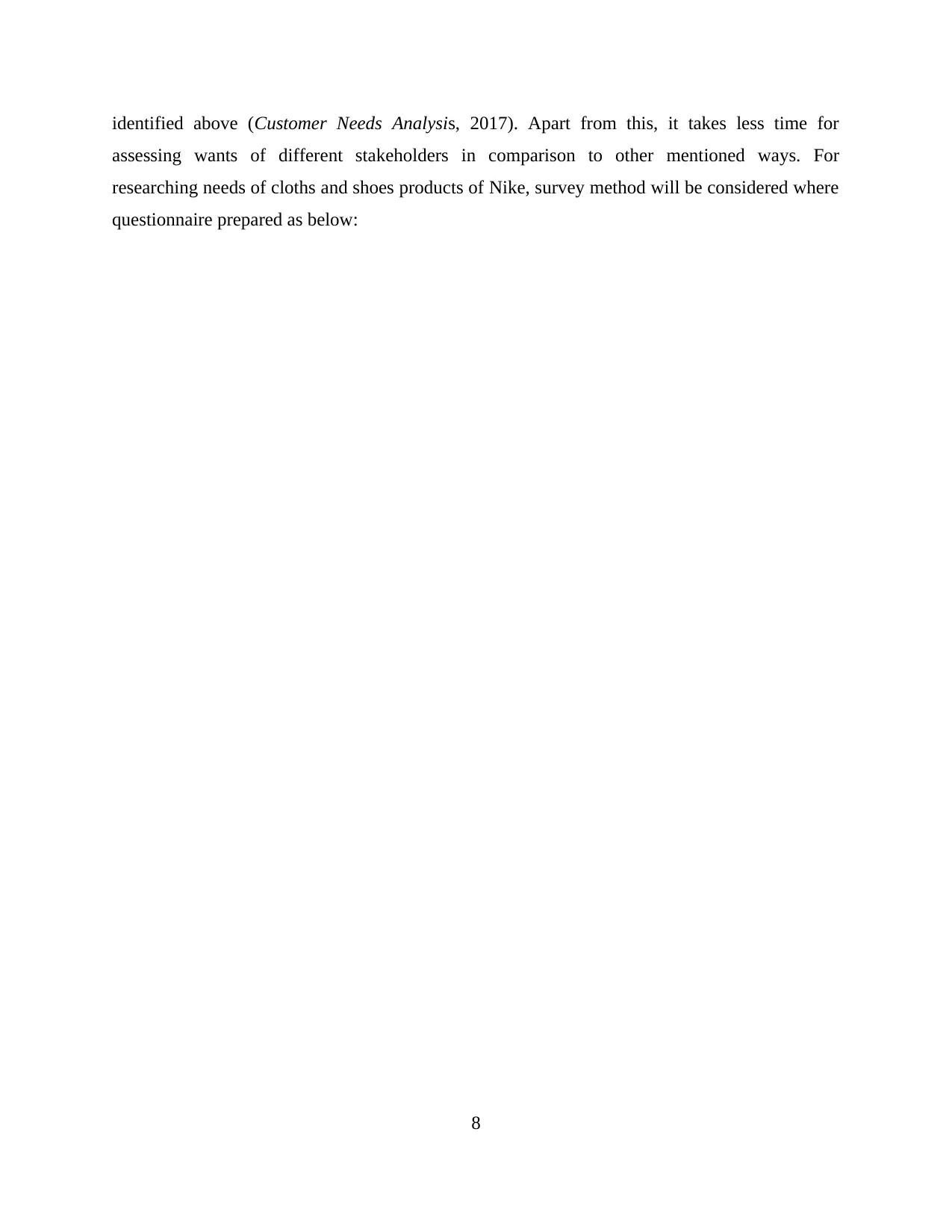
identified above (Customer Needs Analysis, 2017). Apart from this, it takes less time for
assessing wants of different stakeholders in comparison to other mentioned ways. For
researching needs of cloths and shoes products of Nike, survey method will be considered where
questionnaire prepared as below:
8
assessing wants of different stakeholders in comparison to other mentioned ways. For
researching needs of cloths and shoes products of Nike, survey method will be considered where
questionnaire prepared as below:
8
⊘ This is a preview!⊘
Do you want full access?
Subscribe today to unlock all pages.

Trusted by 1+ million students worldwide
1 out of 38
Related Documents
Your All-in-One AI-Powered Toolkit for Academic Success.
+13062052269
info@desklib.com
Available 24*7 on WhatsApp / Email
![[object Object]](/_next/static/media/star-bottom.7253800d.svg)
Unlock your academic potential
Copyright © 2020–2025 A2Z Services. All Rights Reserved. Developed and managed by ZUCOL.





